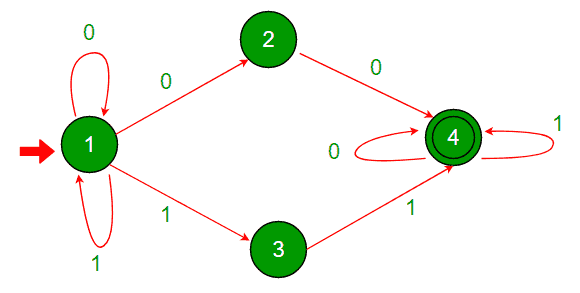出身背景
null
NFA通常使用有向图来描述。每个边和顶点都标记为0或1,表示可能的过渡。顶点表示NFA的状态。标记为0的是非接受状态,标记为1的是接受状态。
- 它需要一个有限长度的输入字符串。通常,输入字符串是0和1的二进制序列。
- 我们从顶点1开始,它始终是起始状态,然后按照输入字符串的位顺序指定的边,直到输入字符串没有其他位为止。
- 术语“非确定性”意味着在任何状态下,我们都有一个以上的选择来跟随一条边。NFA使用输入字符串,状态集Q表示NFA的可能移动。
- 如果Q至少包含一个最后一个顶点接受的状态,那么我们说NFA接受了输入字符串,否则NFA拒绝了输入字符串。
- 每个NFA都不是DFA,但每个NFA都可以翻译成DFA。
NFA的例子:

Starting state - vertex 1Accepting states - Vertices with double circles(label 1) // Vertex 4Non accepting states - single circles (label 0). // Vertices 1, 2 and 3.
如何检查字符串的验收?
输入:1010
- 在状态1中,我们有两种可能性,要么跟随自循环并保持在状态1,要么跟随标记为1的边并进入状态3。
{1} 1010 --> {1, 3} 010
- 在状态3中,没有标记为0的边,因此计算将消失。
- 在状态1中,我们有两种可能,要么跟随自循环并保持在状态1,要么跟随标记为0的边到状态2。
{1, 3} 010 --> {1, 2} 10
- 现在,状态2没有标记为1的边。计算将消失。我们有两种可能性:要么跟随自循环到状态1,要么跟随标记为1的边到状态3。
{1, 2} 10 --> {1, 3} 0
- 在状态3中,没有标记为0的边。因此,计算将消失。在状态1中,我们有两种可能性:要么跟随自循环到状态1,要么跟随标记为0的边到状态2。
{1, 3} 0 --> {1, 2}
- 现在NFA已经消耗了输入。它可以处于状态1或状态2,这两种状态都是不可接受的。所以 NFA已拒绝输入1010。
输入:1100
{1} 1100 --> {1, 3} 100 {1, 3} 100 --> {1, 3, 4} 00 {1, 3, 4} 00--> {1, 2, 4} 0 {1, 2, 4} 0--> {1, 2, 4}
- 现在NFA已经消耗了输入。它可以处于状态1、2或4。第四州是一个接受州。所以 NFA接受字符串1100。
- 我们可以很容易地验证给定的NFA是否接受所有以“00”和/或“11”作为子字符串的二进制字符串。
模拟非确定性有限自动机(NFA)的C程序
输入格式: NFA的邻接列表表示形式如下所示。 给出的示例将表示为 边缘总数:4 边缘连接: 1 0 4 0 1 0 2 1 1 1 3 2 0 1 0 4 3 0 1 1 4 4 1 2 0 4 1 4
输出格式: NFA按照字典顺序接受的前10个二进制字符串(e表示空字符串):{e,0,1,00,01,10,11000,…}
给定测试用例的样本输出如下: 00 11 000 001 011 100 110 111
C
#include <stdio.h> #include <stdlib.h> #include <string.h> #include <stdbool.h> #include <math.h> int row = 0; // A structure to represent an adjacency list node struct node { int data; struct node* next; char edgetype; } typedef node; // Adds an edge to an adjacency list node* push(node* first , char edgetype , int data) { node* new_node = (node*) malloc ( sizeof (node)); new_node->edgetype = edgetype; new_node->data = data; new_node->next = NULL; if (first==NULL) { first = new_node; return new_node; } first->next = push(first->next,edgetype,data); return first; } //Recursive function to check acceptance of input int nfa(node** graph, int current, char * input, int * accept, int start) { if (start==( int ) strlen (input)) return accept[current]; node* temp = graph[current]; while (temp != NULL) { if (input[start]==temp->edgetype) if (nfa(graph,temp->data,input,accept,start+1==1)) return 1; temp=temp->next; } return 0; } //Function to generate binary strings of size n void generate( char ** arr, int size, char *a) { if (size==0) { strcpy (arr[row], a); row++; return ; } char b0[20] = { ' ' }; char b1[20] = { ' ' }; b0[0] = '0' ; b1[0] = '1' ; //Recursively generate the binary string generate(( char **)arr, size-1, strcat (b0,a)); //Add 0 in front generate(( char **)arr, size-1, strcat (b1,a)); //Add 1 in front return ; } // Driver program to test above functions int main() { int n; int i, j; scanf ( "%d" , &n); //Number of nodes node* graph[n+1]; //Create a graph for (i=0;i<n+1;i++) graph[i]=NULL; int accept[n+1]; //Array to store state of vertex for (i=0; i<n; i++) { //Index of vertex , Acceptance state , Number of edges int index,acc,number_nodes; scanf ( "%d%d%d" ,&index,&acc,&number_nodes); accept[index]=acc; //Store acceptance for (j=0;j<number_nodes;j++) //Add all edges { int node_add; int edge; scanf ( "%d%d" ,&edge,&node_add); graph[index] = push(graph[index], '0' +edge,node_add); } } int size = 1; //Size of input int count = 0; //Keep count of output strings if (accept[1]==1) //Check for empty string { printf ( "e" ); count++; } while (count < 11) { char ** arr; int power = pow (2,size); arr = ( char **) malloc (power* sizeof ( char *)); for (i=0;i<power;i++) arr[i] = ( char *) malloc (size* sizeof ( char )); char a[20] = { ' ' }; generate(( char **)arr,size,a); //Generate inputs for (i=0; i<power; i++) { char input[20] = { ' ' }; for (j=0; j<size; j++) { char foo[2]; foo[0] = arr[i][size-1-j]; foo[1] = ' ' ; strcat (input,foo); //Copy generated string input } int result = nfa(graph,1,input,accept,0); // Store result of nfa if (result==1) { printf ( "%s" ,input); // Print if accepted count++; } if (count==10) return 0; } size++; //Increment size of binary string input row=0; } return 0; } |
输入:
41 0 4 0 1 0 2 1 1 1 32 0 1 0 43 0 1 1 44 1 2 0 4 1 4
输出:
001100000101110011011100000001
本文由 阿尔琼·穆尔拉贾尼。 如果您发现任何不正确的地方,或者您想分享有关上述主题的更多信息,请写评论
© 版权声明
文章版权归作者所有,未经允许请勿转载。
THE END


![关于”PostgreSQL错误:关系[表]不存在“问题的原因和解决方案-yiteyi-C++库](https://www.yiteyi.com/wp-content/themes/zibll/img/thumbnail.svg)





